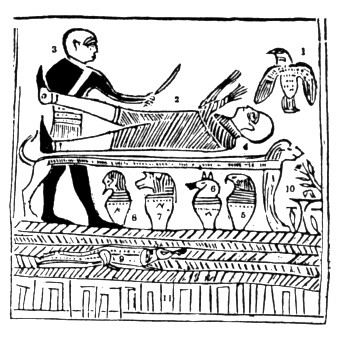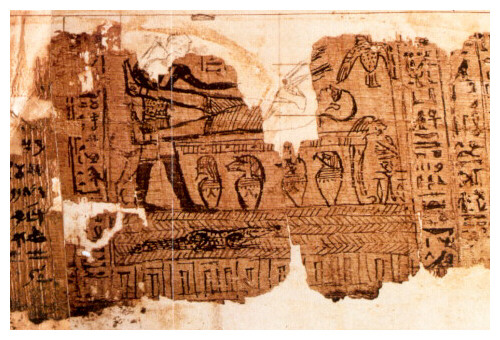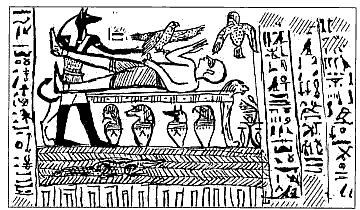I would imagine that my reaction and thoughts were the same as most who are not members of the LDS Church when opening up The Book of Abraham for the first time: fascination and curiosity. Even Mormons might have the same reaction if they were converts to the Church and then discovered The Book of Abraham themselves for the first time. I would venture to say that the reaction of either of these groups would pale in comparison to the reaction of Mormons when Michael Chandler rode into Kirtland, Ohio on July 3, 1835. His wagon cart contained four Egyptian mummies with papyri. Joseph Smith desired to have these artifacts and some Mormons gave Chandler $2,400 for them. That was a large sum of money back then. I wonder what the equivalent would be today?
Joseph Smith made bold claims about the papyri parchments. He stated that these were the writings of Abraham while he was living in Egypt. He further explained that these were written by hand by Abraham himself! Smith claimed that he could translate the Egyptian language, a language practically unknown in America at the time. This wasn’t the first time Smith claimed the supernatural ability to translate an Egyptian-based language: The Book of Mormon was supposedly written originally in “Reformed Egyptian”.
“The remainder of this month, I was continually engaged in translating an alphabet to the Book of Abraham, and arranging a grammar of the Egyptian language as practiced by the ancients” (Documented History of the Church 2:238)
After Joseph’s death, Emma Smith remarried a man named Lewis Bidamon. The scrolls that belonged to Joseph Smith were sold and thought to be lost until they were rediscovered in New York over 100 years later. A certification letter from Emma was found with the parchments verifying that they were the property of Joseph Smith.
“In 1966, Dr. Aziz S. Atiya of the Metropolitan Museum of Art in New York, discovered papyri known to have been used by the Prophet Joseph Smith in producing the Book of Abraham.” (Improvement Era, January 1968, p. 12)
With this discovery one can only imagine again what excitement was taking place in the Mormon community. Could this finally be the proof that the LDS Church had been looking for to validate their founding prophet, Joseph Smith, as prophet, seer, revelator? Until this point the LDS Church had no other manuscript evidence to validate their scriptures. The LDS Church claimed that the golden plates, the ones supposedly used by Joseph Smith to translate the Book of Mormon, had been taken back by the angel Moroni. Mormons now had manuscript evidence for their scriptures with The Book of Abraham. Surely now it would be possible to validate Joseph Smith as divinely appointed by God.
The experts in Egyptology were called in to examine the papyri and the news wasn’t good. It appeared that these papyri showed no relationship to Abraham. The name of Abraham wasn’t even mentioned in the parchments. Instead, the papyri were from the Book of the Dead which was a common Egyptian funerary text. The papyrus was written for a man named Hor. He was a priest of Amon-Ra. Hor died around A.D. 60 – long after the time of Abraham!
“It has been proven that the Book of Abraham collection is nothing more than a common collection of Egyptian funeral documents that are based on pagan myths related to Egyptian idolatry.” (Dialogue: A Journal of Mormon Thought, Autumn 1968, pp. 109-34)
What particularly fascinated me were the facsimiles that are presented throughout The Book of Abraham. There are three facsimiles. Pictured below is the first one:

The parchments that Joseph Smith had were torn in many places so Joseph Smith had to fill in what was missing from the parchments he had purchased from Michael Chandler. The parchment found in New York that belonged to Joseph Smith is pictured below. You can see what was missing and how Joseph Smith filled in the missing pieces.

How close were Joseph Smith’s divine drawing skills given through revelation and inspiration in putting these missing pieces back together again? Egyptologists state this portrayal by Joseph Smith in Facsimile No. 1 is not accurate – not even close. The actual portrayal of the missing pieces in the parchment is quite common as part of the funerary text in the Book of the Dead. Compare Joseph Smith’s rendition with the actual Egyptian portrayal:

It’s very clear that Joseph Smith was way off on his “divine” drawings. A complete analysis of this picture above is given by Bill McKeever and you can see the presentation here:
Notice some of the characters seen in the picture above. Several of them will be mentioned again in the series of blog posts. Egyptologists state that the figure on the far left is the jackal-headed god Anubis. He is embalming Osiris who is lying on the lion-headed embalming couch. (This isn’t Abraham!). The bird with the human head to the far right is the soul of Osiris about to enter his body. Isis, wife of Osiris, has taken the form of a falcon and is on top of Osiris’ phallus (male organ) which he is holding to impregnate her with his future son Horus. The four sons of Horus are shown as the heads of the canopic jars below the couch. Their names are Amset, Hapi, Duamutef, and Qebehsenuef. In the water below is the crocodile god Sobek.
It is amazing to see the difference between Joseph Smith’s creation and the actual portrayal from the Book of the Dead side by side. How can any person honestly and sincerely not admit that there is a credibility problem with Joseph Smith? In the next segment of this series we will look at Facsimile No.2 to see what other messages Joseph Smith supposedly received for us from his god.

Jim Olsen,
“One such example includes the story of a person who was sacrificed on an alter by the priest of Pharoah.”
Do you have a source for this statement? Is there any proof that egyptians sacrificed humans?
Jim Olsen said: “In the rush to win the argument, most critics are blinded to some pretty interesting finds and correlations.”
Jim supplies a lot of information, but gave no references. I assume it’s all from BYU and from John Gee. They have no choice. They have to defend Joseph Smith no matter what the cost. John Gee and the LDS Church are in a “lonely camp” when it comes to their view on these Egyptian papyri. I’ve asked for a list or even one name of an Egyptologist outside of BYU that agrees that Joseph Smith’s explanations of the parchments are correct.
Egyptologist that aren’t Mormons and many of them aren’t even Christians but are possibly Muslim or some other faith aren’t out to win any argument. They could care less about the Mormon Church, what Mormons believe or anyone else for that matter. They reviewed the material because they are experts in Egyptology and gave their conclusions. Every one of them I know about say the same thing: JOSEPH SMITH GOT IT WRONG.
My questions are less about facts and more about rationale, but yet I don’t get answers from Mormons either. I had asked earlier in this thread why LDS cling to JS in light of evidence against him and I can only conclude that it is like an unhealthy love affair. Just as a woman stays with an evil man, LDS stay with JS. She clings to familiarity and financial security. She wants to believe that he will eventually change or come through for her. She wants to believe in his promises. Too bad all her dreams and love are based on ideas and ideals in her head and not based on his actions.
Jim,
“In the Testament of Abraham, another pseudoepigraphic document”
Which means it wasn’t written by Abraham, and that goes for any other pseudepigraphacal work. “False Writings” do not help the case for the BoA.
We are not in a rush to condemn the BoA. The issues and evidence have been around for a while and many people (some here) have looked long and hard at this thing from every angle.
The problem you have is the Egyptian pictures and text in the PoG do not match the English text. J. Smith’s grammar shows the man did not know Egyptian. Are you really suggesting that Smith did not use any of the papyri we have today to render his “translation” of the BoM?
Enki,
Is there a greater point you are trying to make?
Yes, in the ancient world as well as today individuals would sometimes write down some text in their own language but using the script of another. Many street and highway signs in Asia to this today.
Yes, there are times when pagans have taken Jewish and/or Christian writings or religous characters and have used them some how. Witches envoking the names of Biblical angels comes to mind. I have heard at times, Christian missionaries have been leery of giving a Bible to certain native bands because it is perceived by them to be a “magic” book and will treat it as such.
But how does this pertain to the BoA? Is there a greater point here?
Olson Jim, there are many texts that have names, places, and events that are similar to Biblical texts, but were never canonized by the Jews or later Christians. Off the top of my head I think of the Apocrypha, which has some historical value, but some of its elements give evidence that it is not inspired writing on par with the Biblical text. To add insult to injury, Jesus never quotes any of the Apocryphal writings nor do any of the writers of the NT, who you would call prophets. We also have the gnostic gospels, and although they contain the names of the Apostles and the name of our Lord, they are not considered scripture for a variety of reasons.
We also have writings from Babylon that speak of Beltashazzar, who we know as Daniel, and the siege of Jerusalem. Just because they contain the names and events corresponding to the Biblical record, do we regard them as scripture? The Q’uran contains the names of Abrham, Isaac, Jacob, and Moses. Do we use that to modify our Christian faith?
The point is that theology matters. We do not go after gods or theology of extra-biblical text just because it contains similar information. God has preserved His word like no other set of writings. The theology of those writings are our standard. Why do you think Moses gave the commandments to Israel in Deuteronomy 13 and 18 about fals prophets and false gods? If there is no standard men will be deceived. It is in our nature.
Correction. Should not be:
“translation” of the BoM?
Should be:
“translation” of the BoA?
David,
Oh, is that what it is…I never thought for a moment that the passage was used in a different context. Its curious what would be the significance of Psalm 20 to a pagan.
It still leaves me wondering why aramaic was used in the O.T. and not pure hebrew,
Hank Saint,
You don’t have to agree with me, but I can at least say I have exegeted the Matthew 16 passage that you seem to know all about. Have you done the same? What scholarly study have you done regarding this passage so that you can say that the Rock is revelation? The Rock is Jesus Christ, and when I said that you felt the need to include Him in your interpretation–after the fact. But, that is what Jesus has become to Mormons–an after-the-fact addition. This is what Mormonism has done to God’s grace, as well–“after all we can do.” I forget which poster said this, but I agree that Mormons don’t see Jesus in the Bible but themselves. Your attempt at sarcastic humor only reveals how ignorant you really are–and I am using ignorant because you ignore the Truth and exchange the Truth for a lie. I think it’s curious that you didn’t comment on my remark that the Catholic Church has a strong case for Peter being the first pope based on this passage. What do you say about the keys? What has your exegetical study revealed about them? Also, are you willing to say that Jesus didn’t know what He was talking about in light of the fact that you hold to the belief that the Church He established didn’t last long according to Mormon doctrine? Think about that–the Church Jesus established didn’t last, and the Church JS established has lasted longer than Jesus’, so we can think of JS as being more successful than Jesus. Do you see where your theology takes you when you run it out to its conclusion?
Peace…
Enki wrote “It still leaves me wondering why aramaic was used in the O.T. and not pure hebrew,”
Enki,
You’d have to get into the history of the Bible for a complete answer. The short version is that “pure” Hebrew was commonly used up to the Exile (circa 590 BC), and Aramaic was used afterwards. This gives some indication of what was written when, but there’s a whole sea of opinion about the redaction of the various texts (look up what “redaction” means, when you can).
I believe that one issue that we need to be mindful of is that the Bible is NOT a homogeneous block of text; it was written by dozens of different people, using different languages, over a period of, perhaps, 1500 years (the timescale depends on how “traditional” or “liberal” you want to be, but its certainly not less than 700 years).
In a time when words were extraordinarily expensive, the Bible marks one of humanity’s greatest achievements (I believe its more than that, but its certainly not less). The Egyptians built the pyramids as an outpouring of their culture; think of the effort that they expended on their enterprise. We have the Hebrews to thank for putting in a similar effort to produce and preserve this remarkable collection of writings.
Its not the language that unites the Biblical texts, or even, arguably, its idioms and stories; its the over-arching theme that there is one God, who created the heavens and the earth, and it is this God who has bound himself to his people.
liv4jc wrote “To add insult to injury, Jesus never quotes any of the Apocryphal writings nor do any of the writers of the NT, who you would call prophets.”
liv4jc,
I’d have to disagree with you here, at least in part. Jude quotes literally from an apocyphal book (the “Assumption of Moses”, if I recall correctly) in Jude 1:9. But then, Paul quotes a couple of secular philosophers in Athens (Acts 17:28 – archaeologists have actually found the texts that Paul quotes from).
It seems that the Biblical Authors were not afraid to borrow language, stories and quotes from surrounding cultures. What is remarkable, however, is how they used them.
(PS before Enki or someone else chimes in with the idea of the Horus/Sun God myth being the origins of the Christian revelation, it should be recognised that surrounding cultures could equally have borrowed from the Bible).
I fully agree with your conclusion, though. Just because a “scripture” sounds Biblical, or contains Biblical stories, it does not qualify it as authoritive. The Qur’an is a prime example; it even sets out “alternative” accounts of Mary and Jesus, though most of its sources can be traced to Gnostic writings (the Infancy Gospel of Thomas, in particular).
The message of the “scripture” is important. On that criterion alone, we can safely dismiss the Book of Abraham.
Martin,
“It seems that the Biblical Authors were not afraid to borrow language, stories and quotes from surrounding cultures. What is remarkable, however, is how they used them.”
That is understandable if one were trying to appeal to a mostly gentile audience, and sticking to jewish themes were not working. The documentary “From jesus to christ” makes a commentary about that. There is also some conspiracy theories about exactly WHY non-hebrew ideas where used in that manner to appeal to gentile sensibilities.
“PS before Enki or someone else chimes in with the idea of the Horus/Sun God myth being the origins of the Christian revelation, it should be recognised that surrounding cultures could equally have borrowed from the Bible.”
That is a possibility, but how does one objectively determine which is the case?
Some themes seem to have developed independently around the world. One is example is ‘Yupik antigone’. The yupik eskimo people have a story which which bares a close resemblence to the greek story. The symbol of the swastika had been used by a variety of cultures prior to nazi germany, but it was a little bit different.
Martin,
Biblical redaction, thats a topic which sounds interesting, although complex. I have heard that the exact way in which the bible was composed and arranged was perhaps not exactly how most people think. thank you for sharing.
Pingback: Sunday in Outer Blogness: Back to School Edition! | Main Street Plaza